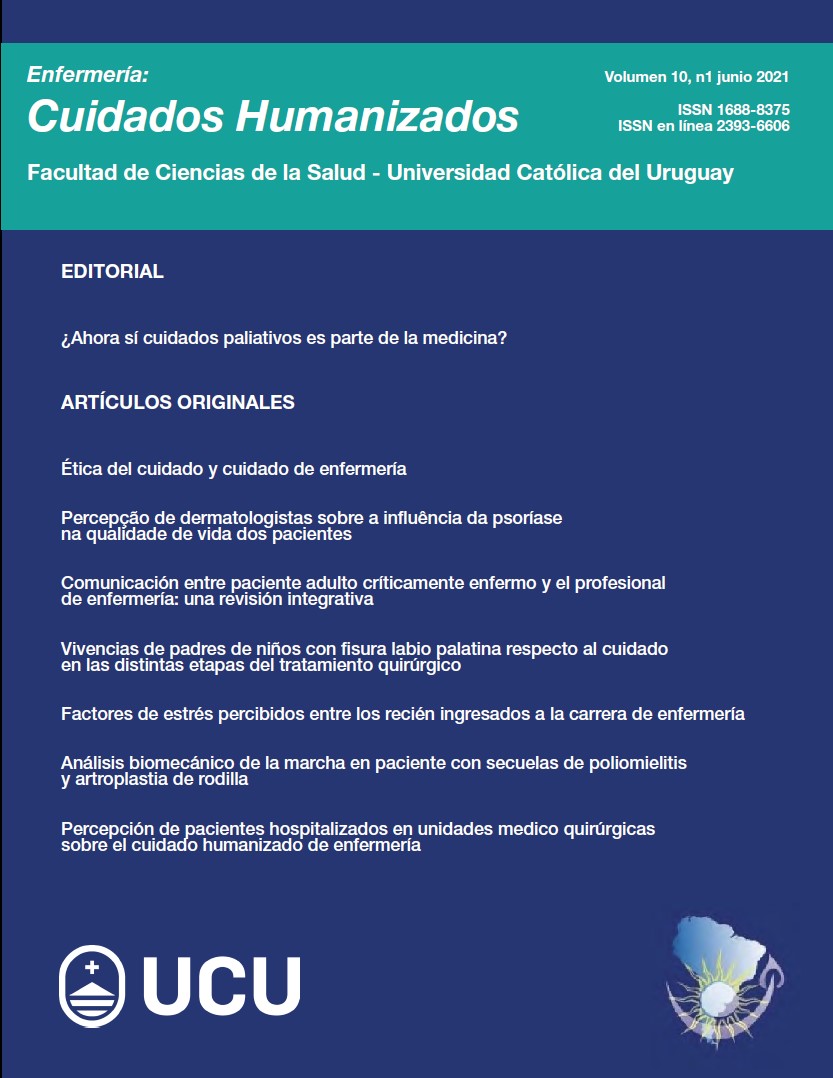Análise biomecânica da marcha em um paciente com sequelas de poliomielite e artroplastia do joelho
DOI:
https://doi.org/10.22235/ech.v10i1.2359Palavras-chave:
Síndrome pós-poliomielite, Artroplastia do Joelho, análise de marcha, fenômenos biomecânicosResumo
A poliomielite é uma doença que pode causar sequelas irreversíveis, causando perda de força muscular, paralisia e hiporreflexia, entre outras. Hoje as infecções por poliovírus são controladas, mas ainda existen pessoas en tratamento pelas sequelas que podem danificar sua qualidade de vida e funções diárias, como caminhar. Esgotadas as opções de tratamento conservador, a artroplastia total do joelho (ATJ) é uma das intervenções cirúrgicas mais comuns quando as sequelas afetam a morfologia e a funcionalidade dessa articulação. O objetivo deste trabalho é realizar uma análise instrumentada da marcha de um paciente com sequela de poliomielite e ATJ, a fim de definir as melhores estratégias de reabilitação e melhorar a recuperação da funcionalidade máxima. O estudo foi realizado em um Laboratório de Análise de Movimento com 8 câmeras, por meio da colocação de marcadores reflexivos no corpo do paciente. Os resultados mostram alterações no padrão de marcha em todas as articulações dos membros inferiores e em cada um dos planos anatômicos, sendo as mais relevantes a rotação interna do quadril direito e a flexão fixa do joelho ipsilateral a 9 ° durante o primeiro ciclo do meio da marcha. A análise sugere que o paciente adote estratégias que favoreçam a ativação do tensor da fáscia lata como flexor do quadril e estabilizador do joelho na extensão máxima disponível (9 ° de flexão), substituindo o músculo quadríceps, enfraquecido pelas sequelas de poliomielite.
Downloads
Referências
Patterson BM, Insall JN. Surgical management of gonarthrosis patients with poliomyelitis. J Arthroplasty. 1992; 7(Suppl.): 419-426.
Giori NJ, Lewallen DG. Total knee arthroplasty in limbs affected by poliomyelitis. J Bone Joint Surg. 2002; 84(7): 1157-1161.
Perry J, Burnfield JM. Gait Analysis: Normal and Pathological Function. 2ª ed. New Jersey: Slack Incorporated; 2010.
Organización Mundial de la Salud. Notificados a la OMS el 1 de marzo de 2019. Poliomielitis [Internet]. Ginebra: OMS; 2020 [consultado 24 oct 2020]. Disponible en: https://www.who.int/es/news-room/fact-sheets/detail/poliomielitis.
Rahman J, Hanna SA, Kayani B, Miles J, Pollock RC, Skinner JA, et al. Custom rotating hinge total knee arthroplasty in patients with poliomyelitis affected limbs. Int Orthop. 2015; 39(5): 833-838.
Jordan L, Kligman M, Sculco TP. Total knee arthroplasty in patients with poliomyelitis. J Arthroplasty 2007; 22(4): 543-548.
Tigani D, Fosco M, Amendola L, Boriani L. Total knee arthroplasty in patients with poliomyelitis. Knee. 2009; 16(6): 501-506.
Prasad A, Donovan R, Ramachandran M, Dawson-Bowling S, Milington S, Bhumbra Rej, et al. Outcome of total knee arthroplasty in patients with poliomyelitis: A systematic review. EFORT Open Rev. 2018; 3(6): 358-362.
Dauwe J, Vandenneucker H. Indications for primary rotating-hinge total knee arthroplasty. Is there consensus? Acta Orthop Belg. 2018; 84(3): 245-250.
Partezani C, Nogueira P, Maftoum C, Gomes R, Kawamura M, Luis G. Knee arthroplasty with rotating -hinge implant: an option for complex primary cases and revisions. Rev Bras Ortop. 2018: 53(2); 151-157.
Yang JH, Yoon JR, Oh CH, Kim TS. Primary total knee arthroplasty using rotating-hinge prosthesis in severely affected knees. Knee Surg Sports Traumatol Arthrosc. 2012: 20(3); 517-523.
Kirschberg J, Goralski S, Layher F, Sander K, Matziolis G. Normalized gait analysis parameters are closely related to patient-reported outcome measures after total knee arthroplasty. Arch Orthop Trauma Surg. 2018; 138(5): 711-717.
Dominguez F, Igual C, Silvestre A, Roig S, Blasco JM. Effects of balance and proprioceptive training on total hip and Knee replacement rehabilitation: A systematic review and meta-analysis. Gait Posture. 2018; 62: 68-74.
Kendall FP, McCreary EK. Kendall’s músculos: Pruebas funcionales, postura y dolor. 5a. ed. Madrid: Marbán; 2007.
Taboadela C. Goniometría: una herramienta para la evaluación de las discapacidades laborales. 1a ed. Buenos Aires: Asociart ART; 2007.
Davis RB, Ounpuu S, Tyburski D GJ. A gait analysis data collection and reduction technique. Hum Mov Sci. 1991; 10: 575-587.
Kadaba MP, Ramakrishnan HK . Measurement of Lower Extremity Kinematics During Level Walking. J Orthop Res. 1990; 8: 383-892.
McGinley JL, Baker R, Wolfe R, Morris ME. The reliability of three-dimensional kinematic gait measurements: A systematic review. Gait Posture. 2009; 29(3): 360-369.
Baker R. Gait analysis methods in rehabilitation. J Neuroeng Rehabil. 2006; 3: 1-10.
Cappozzo A, Catani F, Della Croce AL. Position and orientation in space of bones during movement: anatomical frame definition and determination. Clin Biomech. 1995; 10(4): 171-178.
Collins TD, Ghoussayni SN, Ewins DJ, Kent JA. A six degrees-of-freedom marker set for gait analysis: Repeatability and comparison with a modified Helen Hayes set. Gait Posture. 2009; 30(2): 173-180.
Schwartz MH, Rozumalski A. A new method for estimating joint parameters from motion data. J Biomech. 2005 Jan; 38(1): 107-116.
Ehrig RM, Taylor WR, Duda GN, Heller MO. A survey of formal methods for determining the centre of rotation of ball joints. J Biomech [Internet]. 2006; 39(15): 2798-2809. Disponible en: http://www.ncbi.nlm.nih.gov/pubmed/16293257
Camomilla V, Cereatti A, Vannozzi G, Cappozzo A. An optimized protocol for hip joint centre determination using the functional method. J Biomech. 2006; 39(6): 1096-1106.
Ehrig RM, Taylor WR, Duda GN, Heller MO. A survey of formal methods for determining functional joint axes. J Biomech [Internet]. 2007; 40(10): 2150-2157. Disponible en: http://www.ncbi.nlm.nih.gov/pubmed/17169365
Portnoy S, Schwartz I. Gait characteristics of post-poliomyelitis patients: Standardization of quantitative data reporting. Ann Phys Rehabil Med. 2013; 56(7-8): 527-541.
Brogardh C, Flansbjer VB, Lexell J. Determinants of falls and fear of falling in ambulatory persons with late effects of polio. PM R. 2017; 9(5): 455-463.
Simonsen E, Cappelen K, Skorini R, Larsen P, Alkjær T, Dyhre-Poulsen P. Explanations pertaining to the hip joint flexor moment during the stance phase of human walking. J Appl Biomech. 2012; 28(5): 542-550.
Trammell AP, Nahian A, Pilson H. Anatomy, Bony Pelvis and Lower Limb, Tensor Fasciae Latae Muscle [citado May 7 2020]. En: StatPearls [Internet]. Disponible en: https://www.ncbi.nlm.nih.gov/books/NBK499870/
Kapandji A. Fisiología articular: Miembro inferior. Tomo 2. 1ª ed. Madrid: Panamericana; 2012.
Elkarif V, Kandel L, Rand D, Schwartz I, Greenberg A, Portnoy S. Muscle activity while ambulating on stairs and slopes: A comparison between individuals scheduled and not scheduled for knee arthroplasty and healthy controls. Musculoskeletal Science and Practice. 2021; 52: 102346.
Bianchi N, Facchini A, Mondanelli N, Sacchetti F, Ghezzi R, Gesi M, Capanna R, Giannotti S. Medial pivot vs posterior stabilized total knee arthroplasty designs: a gait analysis study. Med Glas (Zenica). 2021 Feb 1; 18(1): 252-259.
Yoshida Y, Mizner RL, Snyder-Mackler L. Association between long-term quadriceps weakness and early walking muscle co-contraction after total knee arthroplasty. Knee. 2013; 20(6): 426-431.
Marmon AR, Snyder- Mackler L. Activation deficits do not limit quadriceps strength training gains in patients after total knee arthroplasty. Int J Sports Phys Ther. 2014; 9(3): 329-337.
Downloads
Publicado
Como Citar
Edição
Secção
Licença
Direitos de Autor (c) 2021 Enfermería: Cuidados Humanizados

Este trabalho encontra-se publicado com a Licença Internacional Creative Commons Atribuição 4.0.

















